We use cookies to make your experience better. To comply with the new e-Privacy directive, we need to ask for your consent to set the cookies. Learn more.
Preparation methods
Chinese preparation
In traditional Chinese preparation, the tea is poured into a small porcelain or glass vessel or even a Yixing pot. The pots have a rather small volume of usually only 200-300ml.
First the tea is filled into the pot.
Then you add the water. With teas, such as Pi Lo Chun, it can also be the other way round. Here you first fill the water into the pot and then add the tea on top.
For the first infusion, let the tea steep for a short moment and pour the water into another vessel. Traditionally this is also called "washing" the tea. However, this choice of words has more of a sensual character than the removal of impurities. Rather, the leaves need a little time in the beginning until they are permeated by the water and can develop their full aroma. The first infusion would therefore falsify the taste picture here. With teas that consist of open leaves, the first infusion usually takes only a few seconds. Rolled teas, i.e. teas that are formed into denser, spherical shapes, are given a little more time for the first infusion.
The water from the first infusion is used to pour over the tea cups and utensils and the rest of the infusion water is tipped away.
The drinking vessels are preheated in this way and already take on the aroma of the tea.
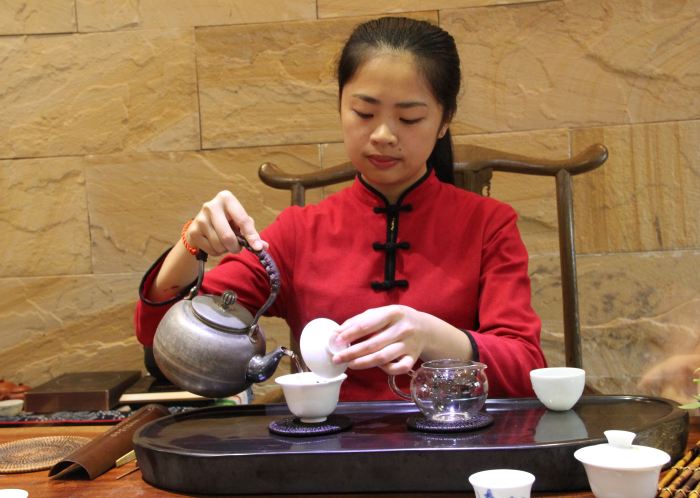
Water tea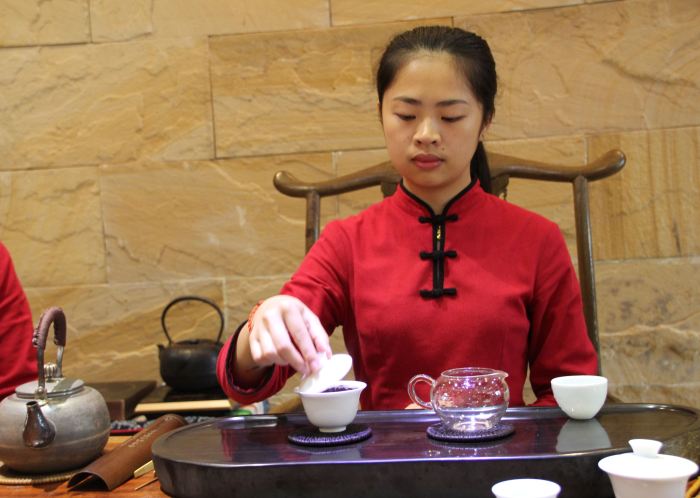
allow to steep and check
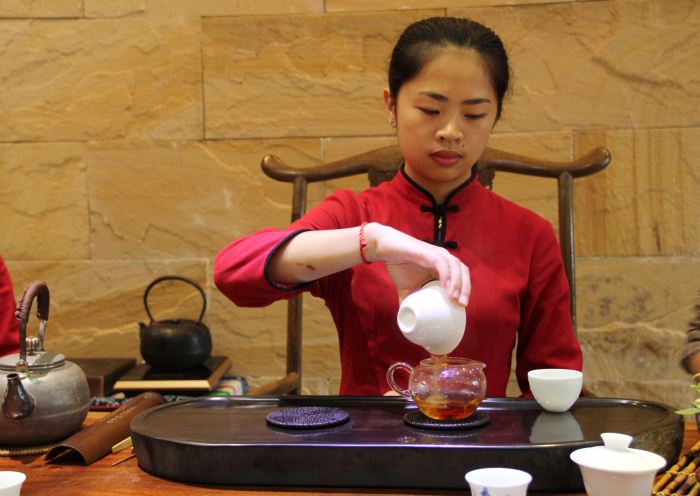
pour over further infusions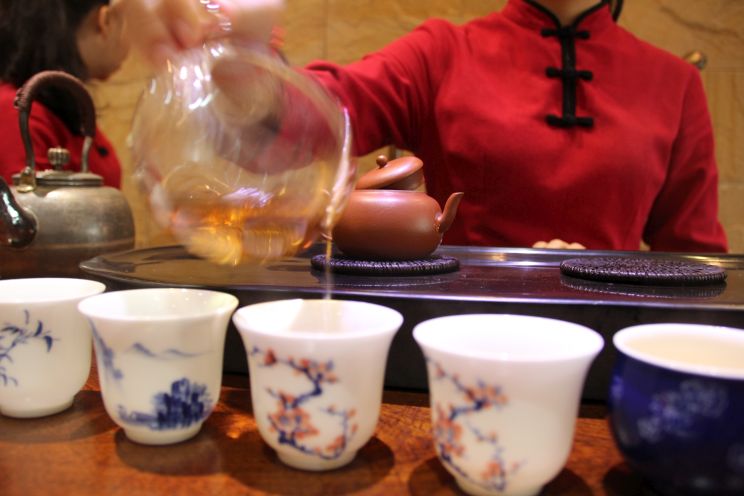
.. and serve the tea with it

Water tea

allow to steep and check

pour over further infusions

.. and serve the tea with it
The leaves in the teapot have now been pre-softened and their aroma can be fully appreciated. Check the smell of the steaming and fragrant tea leaves in the pot or bowl. The tea is then infused and drunk as the infusion time increases. In Chinese preparation, there is a lot of tea in the infusion vessel in proportion to the amount of water. After unfolding, the tea leaves quickly take up the entire interior of the small vessel. The infusion times per infusion are therefore correspondingly short. As a rough guide, infusion times of e.g. 60s+(x-1)*10s are suitable. Because every tea differs in type, size, quality, processing method, dissolution behaviour and last but not least your own preferences have to be taken into account, you should always experiment a little with new teas.
Western preparation
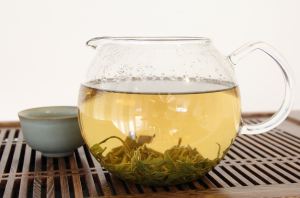
Western preparation Contrary to the Chinese infusion method, where the tea is infused repeatedly with a small amount of water and short infusion times, the Western preparation method is less complex. The loose tea is placed in a container and water is poured over it (often in a ratio of approx. 10-12g of tea per litre of water). You can also use various filters or sieve inserts to achieve a quicker separation of the leaves. The infusion time is already chosen during the first infusion so that the tea's ingredients are optimally dissolved in the water. This is usually around three minutes and depends on the type and composition of the tea. Since the tea is infused with a large amount of water during a longer infusion time, a large part of the tea's ingredients are dissolved in the water during the first infusion. This is why the tea is usually only infused once or twice with the western method of preparation. The information on tea, according to which many infusions are possible, refers to the Chinese preparation method (see above). The aroma weakens noticeably with further infusions, or the tea can become bitter with lower qualities and longer infusions. With the western method, high tea qualities can be infused a second or even third time. However, the necessary infusion times increase considerably with a further infusion (depending on the variety, e.g. with times of x*180s).
Preparation in glass
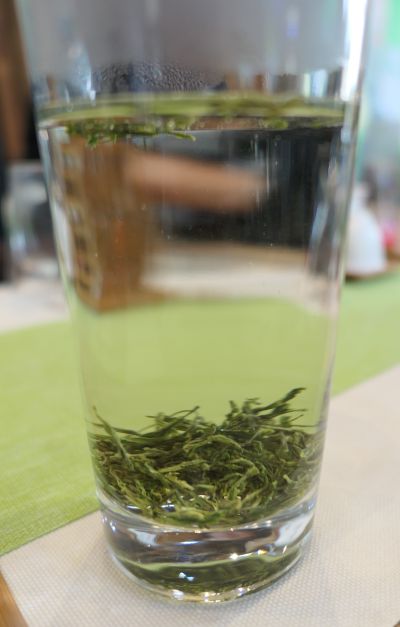
Fresh Enshi Yu Lu prepared in a glass The simplest of all infusion methods requires no more than a drinking glass and a kettle. In China, tea is an everyday companion. Whether in the office or on the road. Usually the tea is poured directly into the glass, poured over with hot water and drunk slowly. When travelling, a thermos flask is often filled with hot water and a few tea leaves are added.
Poured into a glass, the speed at which the tea is brewed and the temperature of the water ultimately determines how fast the tea is brewed. Since in China usually only good qualities of tea are used, infusion directly in a glass is always an option. With increasing tea quality, the ingredients tend to dissolve more evenly and you are less dependent on the exact water temperature. With higher qualities, bitter constituents tend to remain in a harmonious relationship with the aromatic components over a longer period of time, which means that the tea remains tasty for a long time.
You do not have to pay much attention with this method. In addition to a good quality of tea and good water, teas that tend to sink to the bottom of the glass are chosen for easier drinking. Gravity replaces the filter to a certain extent. The tea leaves remain in the glass. Green teas are poured at a temperature of about 80 degrees. White, oxidised and fermented teas are infused with boiling water. The amount of tea leaves can be adjusted according to your preferences or you can add water if necessary.
Conclusion: No matter if you choose the Chinese, the Western or a simple preparation in a glass, you can prepare a very good tea with all methods. The quality of the tea has only an indirect influence on the amount of tea that can be prepared with it. The dosage details are very similar for many teas. The aroma of all teas weakens with increasing infusion time. Apart from the advantages in taste, higher quality teas can usually cope with longer infusion times, allow a wider temperature range during infusion and are easier to handle.

